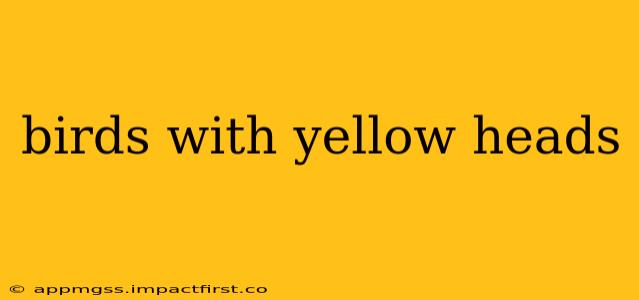Many bird species boast striking yellow heads, making them instantly recognizable and captivating to birdwatchers of all levels. This vibrant plumage often serves as a crucial identification marker, distinguishing them from their counterparts. However, the sheer variety of birds with yellow heads can make identification challenging. This comprehensive guide will delve into some common species, explore the reasons behind their yellow head coloration, and answer some frequently asked questions about these beautiful birds.
What Birds Have Yellow Heads?
This question is broad, as several species across various families feature yellow heads. Some of the most well-known include:
-
Goldfinches (various species): American Goldfinches, Lesser Goldfinches, and others are easily identified by their bright yellow heads (males, especially during breeding season). Their overall coloration, body shape, and habitat preferences further aid in identification.
-
Yellow-headed Blackbirds: These striking birds are unmistakable with their bold black bodies and bright yellow heads. Their behavior and habitat are key factors in distinguishing them from other blackbirds.
-
Yellow-rumped Warblers (Myrtle Warbler and Audubon's Warbler): While their name highlights their rump, many subspecies display a significant amount of yellow on their heads, particularly males during breeding season. Note the differences in the amount of yellow and other markings to differentiate subspecies.
-
Hooded Orioles: These birds display a vibrant orange-yellow head and chest, easily distinguishing them from other orioles. Their habitat and nesting behavior are also valuable identification clues.
-
Eastern Meadowlark: Though not entirely yellow, the male Eastern Meadowlark has a striking yellow head with bold black markings. Their distinctive song and ground-dwelling habits are helpful for identification.
Many other species, such as certain tanagers, woodpeckers, and finches, may also exhibit varying degrees of yellow on their heads, depending on the species, age, and sex.
Why Do Some Birds Have Yellow Heads?
The bright yellow coloration in bird heads, like other plumage colors, often serves several key purposes:
-
Sexual Selection: In many species, the intensity of the yellow coloration is linked to mate selection. Brighter, more saturated yellow might indicate better health and genetic fitness, making those individuals more attractive to potential partners.
-
Camouflage and Warning: In some cases, yellow coloration can act as camouflage in certain environments, helping the bird blend into its surroundings. In other cases, it can serve as a warning signal to predators, indicating toxicity or unpleasant taste.
-
Species Recognition: The distinctive yellow head can aid in species recognition, particularly during mating season or when birds are in flocks. It helps individuals identify potential mates and avoid inter-species breeding.
What Causes the Yellow Color in Birds?
The yellow color in birds' feathers is due to pigments called carotenoids. These pigments are obtained from the birds' diet, primarily through consuming fruits, insects, and other plants rich in carotenoids. The bird's ability to metabolize and deposit these pigments in their feathers contributes to the intensity and vibrancy of the yellow coloration.
What are Some Similar-Looking Birds to Those With Yellow Heads?
Several birds may share some visual similarities with those possessing yellow heads, potentially causing confusion for beginners. Careful observation of size, shape, markings, habitat, and behavior is crucial for accurate identification. For instance, some warblers might be confused with certain flycatchers or vireos, while some blackbirds might resemble grackles. Using field guides and online resources with detailed images and descriptions is extremely helpful in these scenarios.
How Can I Identify Birds with Yellow Heads?
Accurate identification of birds requires careful observation and the use of various resources. Here’s a strategy to help you identify birds with yellow heads:
-
Observe the Bird's Entire Appearance: Don't just focus on the head; consider the overall body shape, size, color of the wings, tail, and underparts, and any distinguishing markings.
-
Note the Habitat: Where did you see the bird? Different birds inhabit different environments. Knowing the habitat can greatly narrow down the possibilities.
-
Listen to Its Song: Bird songs are often unique and are excellent identification clues.
-
Use Field Guides and Online Resources: Many excellent field guides and online resources, such as the Cornell Lab of Ornithology's All About Birds website, provide detailed descriptions and images to aid in identification.
-
Take Photos (if possible): A picture can be invaluable in later identification.
By combining careful observation with the use of appropriate resources, you can successfully identify birds with yellow heads and expand your appreciation for the amazing diversity of avian life. Remember, practice makes perfect! Happy birding!
